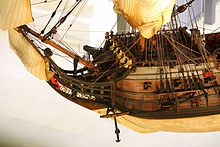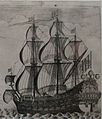Leopoldus Primus

|
||
|---|---|---|
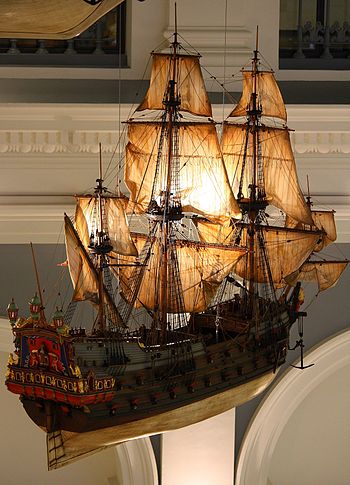 Model of the Leopoldus Primus (modern reconstruction). |
||
| Ship data | ||
| Surname: | Leopoldus Primus | |
| Builder: | Shipyard at Deichtor , Hamburg | |
| Launching ( ship christening ): | 1668 | |
| Crew: | 150–250 officers and crew grades | |
| Technical specifications | ||
| Type: | Two-decker (convoy ship) | |
| Length: | 40 m | |
| Width: | 11 m | |
| Drive: | sail | |
| Armament ( cannons ): | ||
| 18 pounder | 26th | |
| 8 pounder: | 18th | |
| 6 pounder: | 4th | |
| 4 pounder: | 6th | |
| Total : | 54 cannons | |
The Leopoldus Primus was the first convoy of the Free Imperial City of Hamburg in the late 17th century . It was for use against piracy on trade routes to Spain, Portugal and West Africa, and to the accompaniment of whalers to Greenland built and was after the Holy Roman Emperor I. Leopold named. It was put into service in 1668 and after 34 long journeys it was scrapped in 1705. It was probably identical in construction to the better-known Wapen from Hamburg (I) , which was put into service a short time later.
prehistory
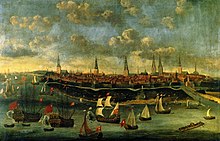

Due to the decline of the Hanseatic League in the course of the 16th century, Hamburg gained increasing importance compared to Lübeck, the leading city in the Hanseatic League . The focus of Hamburg's trade relations also shifted from the North Sea and Baltic Sea area, the most important trading area of Hamburg and the Hanseatic League during the Middle Ages, to the Atlantic and the Mediterranean. This was intensified by the influx of Sephardic Jews from Portugal as well as Protestant and Jewish refugees from the Netherlands, who brought important contacts with them to their home countries. A successful trade developed in cocoa, raisins, tobacco, fabrics and spices, among other things. Raw materials such as cane sugar from the New World came to Hamburg for the first time via trade with the Iberian Peninsula .
During the Thirty Years' War Hamburg behaved strictly neutral and was also well protected against attacks by its fortifications built shortly before the start of the war. Since all warring parties quickly realized that an intact Hamburg would benefit them the most, the war went on for the city without any major disruptions. In the middle of the 17th century, Hamburg managed to become one of the most important trading centers in Europe after London and Amsterdam . Hamburg had trade relations that stretched from Archangelsk in Russia to the Mediterranean ports in the south.
The rides not only promised high profits, but also brought with them a multitude of dangers. In the Mediterranean in particular, merchant shipping was threatened by pirates. The corsairs of the barbarian states of Algiers, Tripoli and Tunis, which were under Ottoman rule, acted here . The barbares captured many merchant ships and their cargo and took the crew as slaves, which they sold on the markets of the western Mediterranean. In a few individual cases, the corsairs even extended their raids to the mouth of the Elbe. Ships from Hamburg were particularly at risk, as the Hamburgers - unlike the great sea powers - did not have sufficient military protection. In order to be able to buy sailors from Hamburg who had fallen into slavery, the first private slave fund was founded in Hamburg in 1622 . It offered the seafarers a kind of insurance so that they could be ransomed from captivity.
After the June 22, 1662 eight fully loaded ships with cargo worth an estimated half million Hamburgischer Courant Mark at the height of Lisbon had been lost to the pirates, the Council and the citizens of Hamburg saw finally forced to take action. They decided to equip armed ships - so-called "convoy ships" - by the Admiralty Board and to have the merchant ships sailed in association and guarded by these convoy ships. Contracts with the leading sea powers were also intended to increase the protection and safety of one's own ships in foreign ports.
Planning and construction
The planning for the construction of the Leopoldus Primus and the probably largely identical Wapen von Hamburg I began in 1663. A first mention of these plans can be found in the minutes of the meeting of the Admiralty on June 4, 1663. The merchant Dietrich Vasmer proposed on behalf of the whole Merchant class before that
"Some ships are built or bought by the city, so capable of defending the Turks again."
Instead of the previously retrofitted merchant ships, full-fledged warships should now protect the Hamburg cargo ships. As early as September 23, the town council suggested that two frigates be built. To finance the ditch, the fee for the construction, fortification and guarding of the city walls and moats should be doubled. A short time later, the citizenship approved the plans.
Little information is available about the construction of the Leopoldus Primus . The start of construction was very much delayed for unknown reasons. It almost seemed that the plans had been forgotten. In February 1665, the Commerzdeputation founded shortly before , a representative of the Hamburg merchants founded by seven “honorable merchants”, warned that the building should be built. On June 27, 1666, the deputation again reminded of the plans, as construction had still not started. On October 31, the approved citizenship again the construction of two ships, the grave of money approved this time but only under the condition that it was to be paid only if the construction had begun.
After the Commerzdeputation in November 1666 and January 1667 again warned that the ship should be built, a dispute broke out as to who should now assume the costs of building the ships. In the midst of an abundance of documents that were exchanged back and forth between the Admiralty and the Commerzdeputation, deliberations and conferences on the distribution of costs, construction still made no progress.
The keel was finally laid in 1667. Now one ship was paid for by the city treasury and the other by the Commerzdeputation and built under the supervision of the respective financier. The construction of both ships was under the direction of an unknown Dutch master shipbuilder and, based on the Dutch model, took place purely by hand, i.e. without construction drawings. All master builders of the time were the owners of closely guarded family secrets that were not put down in writing or passed on. A site near the dike gate served as the construction site. The Hamburg sculptor Christian Precht was responsible for the sculptural work, including the rear figure depicting Leopold I. This figure is exhibited today in the Museum of Hamburg History.
The woodwork was finished in the year the keel was laid, and in February 1668 work began on equipping the ship. In September 1668 the Leopoldus Primus was operational, which was also communicated to the council. However, it seems to have been finished in April, since a note from the Commerzdeputation already mentions a newly built Convoye ship that will be operational this summer. The Leopoldus Primus went on her maiden voyage under her first captain, M. Dreyer .
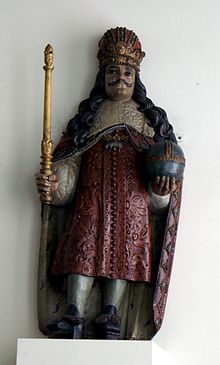
The naming of such an important ship after a strict Catholic emperor in distant Vienna was quite unusual for Hamburg as a city that cared less about imperial affairs. One motive for this is given in a handwritten poem that addresses the problem of choosing a name:
- The Hamburg frigate.
- You nobles, take advice! what do you want to name
- The newly built ship? wobey one should know it
- When does it come to other places? Should it be Neptunus?
- Why a heathen god? A bright starlight
- Like amphora, it would be good, Aquarius of equals,
- But the Argo will hardly give way to this.
- That led fifty-four, so nobly all too many
- So knightly all. The ship in equal numbers
- Also carries so many artillery pieces that one should pay attention to
- There is a reason for this, but one can continue to strive
- To find a name that will be wonderful to all
- The fear of all peoples, which then liberates the ship
- From displeasure, from annoyance, it will have to be said
- The Kayser Leopoldus, whom I lay at his feet
- JVS Philolingius
Apparently the author was referring to the victory of the imperial troops near Mogersdorf under Leopold I against the Turks in 1664, which stopped the advance of the Ottomans in Europe. So having this emperor as patron saint against the Muslim pirates was an obvious idea. In addition, Leopold's trade policy was oriented to the north and he needed Hamburg as an export port for copper and a transhipment point for overseas trade. The Hamburgers welcomed these plans, as they also had a strong ally against the Duke of Holstein , who for a long time denied Hamburg's status as a Free Imperial City .
The friendly relations between the Kaiser and Hamburg stemmed from the time of the Thirty Years' War , during which Hamburg was strictly neutral.
Construction, equipment and crew
There are very few and not very productive documents on the size and appearance, as well as on its sister ship, the Wapen von Hamburg . The dimensions are not recorded. Nothing is known about a model as it was common at the time. Therefore, the appearance of the ship can only be reconstructed using the few authentic images and the preserved building, i.e. the building contract, the Wapen von Hamburg (II) from 1685.
According to this reconstruction, the Leopoldus Primus is a two- deck, fully rigged square sail with a transom . What is certain is that, as in the rest of Europe, the leading Dutch design was imitated for the two ships. Quinger suspects that the Leopoldus Primus and the Wapen von Hamburg were a more or less similar replica of the Dutch admiral ship Aemilia . Accordingly, the Leopoldus Primus had a length of almost 40 m and a width of almost 11 m. In order to get to Hamburg over the shallows in the Elbe, the hull of the Leopoldus Primus was probably built according to the so-called "Rotterdam shape". This means that the hull had a kink in the lower part, which ensured that the ship had a significantly lower draft than ships with a uniformly rounded hull with constant displacement and equally good stability properties.
The stern was smoothly closed by the mirror to which the figure of Leopold pictured above was attached. The transom formed a structural unit together with the side gallery. The transom and the gallery were decorated with ornate baroque carvings and sculptures for reasons of representation. So there were probably two lions above the Leopold figure to end the mirror. The figure was probably framed by various depictions of sea horses, dolphins and other sea animals. Many other parts of the ship were also decorated with sculptures and decorations.
The side wall was planked up to the railing , including the bulwark . The planking of the ship was carried out kraweel , that is, the ends of the planks butted together so that a smooth outer surface was created.
The Leopoldus Primus had three masts, the fore mast with foresail, foresail and foresail, the mainmast with mainsail, mainsail and mainsail and the mizzen mast with cross sail and mizzen sail. She also had a bowsprit with several smaller sails. The sails must have had a color from gray to a light ocher yellow. However, white is to be excluded.
The most important part of the equipment for use as a convoy ship were the guns . The Leopoldus Primus had a total of 54 guns. The heaviest calibers were usually on the lower battery deck, the lighter ones on the upper and on the stern and aft deck. For the sister ship of the Leopoldus Primus , the Wapen von Hamburg , the following caliber distribution was reconstructed, which should also apply in a similar way to the Leopoldus Primus :
- 26 18 pounder guns
- 18 8 pounder guns
- 4 6 pounder guns
- 6 4 pounder guns
The Leopoldus Primus had more gun ports than cannons so that the guns could be moved. The pipes were probably made of cast iron. Bronze is likely to have only been used for a few representative pieces. The guns were partly cast in Hamburg on behalf of the Admiralty, and partly bought in Hamburg or abroad. When the Leopoldus Primus entered the port of Hamburg for a long time, the guns were unloaded and immediately transported to the convoy arsenal responsible for equipping the convoy ships. They were only brought back to the ship for the next voyage. The background to the measure was, among other things, that these guns could also be used for the defense of the city. For example, when Hamburg was attacked by the Danes in 1686, the convoy rifles were brought to the city walls. It was not until May 1687 that the guns were returned to the ships.
The crew of the Leopoldus Primus consisted of around 150 to 250 men, depending on the length and purpose of the voyage. Of these, around 15 to 20 were officers, including the captain, his lieutenant, but also the preacher and the commanding officer of the soldiers. The actual team was only hired for the duration of a trip. In Hamburg, however, as was customary in England at the time, no sailors were pressed into service, but recruited in the city itself and in other important hiring places. The sailors had to take care of their own equipment such as a sea chest, duffel bag, hammock and clothing. Many sailors made the rather poor clothing themselves from cloth waste. The poor hygienic conditions on the ships meant that for every man killed in battle there were up to four crew men who died of illness.
The number of men specified above also included around 40 to 60 men who were temporarily recruited. They were acquired from the permanent, trained crew of the city of Hamburg and assigned by the city commandant to the Leopoldus Primus and the other convoy ships. In contrast to the sailors, they wore the uniform of the Hamburg city troops and, in addition to their actual task in battle, had the task of maintaining discipline and order on board.
Operations and scrapping
The successful use of the Leopoldus Primus is proven by numerous reports. In the late autumn of 1673, for example, Captain Berent Jakobsen Karpfanger and the Leopoldus Primus won a battle against French privateers on the Dogger Bank when they attacked a convoy from Portugal that was protected by the Leopoldus Primus . A year later, Karpfanger came across three Turkish pirate ships near Cape St. Vincent , but they broke off the battle prematurely.
The highlight of the operations of the Leopoldus Primus under Karpfanger was the defense against five French pirate frigates in the Elbe estuary on September 11, 1678. The French frigates targeted a 50-ship convoy of whalers who were on their way home from Greenland to Hamburg. Two French frigates were sunk after a twelve-hour battle and the rest of them were put to flight. There was no loss of ships on the Hamburg side; the Leopoldus Primus itself was only slightly damaged. Only two men of the crew of the Leopoldus Primus were killed and one man was injured. According to legend, Hamburg received the captain of the Leopoldus Primus with a triumphal procession and the council is said to have presented Karpfanger with a gift of 300 Reichstalers .
When ships of the Brandenburg-Prussia fleet crossed the Shetland Islands , in front of the Vlie and in front of Heligoland in 1679, including the frigate Berlin , in order to forcibly collect promised subsidy funds from the Swedish-Brandenburg war in the amount of 150,000 thalers from Hamburg, it happened an encounter between several Hamburg ships, including the Leopoldus Primus and the Wapen von Hamburg , and the Brandenburg fleet . Both sides were ready to fight, but since everyone knew that Hamburg and Brandenburg were in negotiations, this encounter turned out to be mild. Ultimately, it was peacefully agreed that Hamburg would pay the outstanding funds.

In 1681 the Leopoldus Primus under Karpfanger was involved in the rescue of the Spanish silver fleet from an attack by Turkish ships and in August 1686 the Leopoldus Primus rendered important services in the defense of the city against Denmark under Christian V. A decision of the council gave the Admiralty thereby the right to use the Leopoldus Primus at their discretion. Without this commitment and the intervention of Brandenburg and Hanoverian ships, the independence of the city would have been ended by a Danish occupation. In 1693 the Leopoldus Primus was attacked again off Cape St. Vincent, this time by French pirates. Almost all Hamburg ships in the convoy were lost.
In 1702, the Leopoldus Primus was the oldest of the three Hamburg convoy ships that existed at the time. During a convoy voyage to the west, she got caught in a strong storm and was badly damaged. Captain Schröder had to turn around and call at Falmouth in England as a port of refuge. After an inspection, the carpenters did not consider the Leopoldus Primus worth repairs. Schröder reported this to Hamburg along with reports from his officers. The proposal to sell the ship was rejected by the council and the admiralty and the Leopoldus Primus was transferred to Hamburg. After their appraisal, Hamburg experts came to the conclusion that the Leopoldus Primus could be repaired, and it was sometimes said that it could continue to sail for ten years. Thereupon the Leopoldus Primus was repaired for 3500 marks (1166 thalers) and made a trip to Greenland in 1703.
Before the Leopoldus Primus could set off on her next voyage, the convoy college asked the officers and a sailor in March 1705 how the ship had held up during the convoy voyage. The chief boatman was the worst, and the seaman said:
"The ship is good in calm weather, in bad weather he does not ask to sail with it."
Even if some experts were of the opinion that the Leopoldus Primus could make a few more voyages to England, the convoy college decided, in agreement with the council, not to let the Leopoldus Primus go out to sea. This decision was certainly made against the background of the disproportionately high costs that would have required a new repair. After 36 years, the career of Hamburg's first convoy ship came to an end. Since then, nothing has been handed down from the Leopoldus Primus . It seems to have been broken up in 1705, probably in Hamburg.
In total, the Leopoldus Primus made 22 trips to the Iberian Peninsula, three trips to England and nine trips to Greenland to protect whalers. This made her the Hamburg convoy ship with the most missions during her service life. Only the Admiralty of Hamburg could show an approximate balance with 32 trips. All other convoy ships in the city of Hamburg, as they were often built for representational purposes, never did justice to their actual purpose.
Source location and pictorial representations
The only representation that is definitely the Leopoldus Primus can be found on the painting "View of the City of Hamburg from the Elbe Side" by Elias Galli , which is dated around 1680, shown at the beginning . In the painting by Galli you can see the Leopoldus Primus in the foreground as the second ship from the left. To the left of it is her sister ship, the Wapen von Hamburg .
All other depictions, such as on a glass pumpkin from 1672, the painting by JG Stuhr from around 1688 with a city view of Hamburg and in particular copperplate engravings, are based on an engraving by the Hamburg copper engraver and goldsmith Joachim Wichmann from 1675 not the two convoy ships shown, but simply plagiarized an older engraving by the Dutch engraver Wenzel Hollar , which presumably shows the warship de Holland'sche Magd in the Tuin .
The Leopoldus Primus on a detail from the painting View of Hamburg from the Southwest by Johann Georg Stuhr from 1688.
Another representation of the ship Leopoldus Primus (as well as the coat of arms of Hamburg I ) can be found in the book Hertzfliessende Considerations / Von dem Elbe Strom by Peter Hessel , published in 1675 .
literature
- Ernst Baasch: Hamburg's convoy shipping and convoy being: a contribution to the history of shipping and shipping facilities in the 17th and 18th centuries. Hamburg 1896 - Despite its age, this is the only depiction of Hamburg convoy shipping to date that is based on intensive source work.
- Peter Hessel: Heart-flowing considerations / From the Elbe river. Altona 1675, without ISBN.
- Wolfgang Quinger: Coat of arms of Hamburg I. Rostock 1980.
- Carsten Prange: Hamburg and the barbarians - challenges of the Hamburg merchants by the corsairs. In: God's friend - the enemy of the world. Of piracy and convoy travel. published by the Museum for Hamburg History , Hamburg 2001, ISBN 3-9805772-5-2 .
Web links
The Hamburg Chamber of Commerce on the subject of convoy shipping
Individual evidence
- ↑ In sources and secondary literature, some of the Hamburg convoy ships are sometimes referred to as frigates , even if the ships were relatively large two-deckers (that means two gun decks). But they were not frigates in the newer sense of the type of lighter, very seaworthy warships with only one gun deck introduced from the middle of the 18th century. In the 17th and first half of the 18th century, the term "frigate" was used for a number of different types of ships, so that many ships from very small "single decks" to relatively large "double deckers" could be called this.
- ↑ The calibers cannot easily be specified in cm, because it is not known which pound measurement is used and how much play (difference between bore diameter and ball diameter) the tubes had. The cannons probably had the bore diameter: 18 pounds = 12.7 cm gun with 18 pounds per bullet; 8 pounders = 10.2 cm gun with 8 pounds per bullet; 6 pounder = 9.4 cm gun with 6 pounds per bullet; 4 pounders = 3 inch gun with 4 pounds per bullet.
- ↑ quoted from Baasch, p. 134
- ↑ Manuscript poem from the anthology Writings Concerning the Admiralty ( Commerzbibliothek Hamburg), here quoted from Baasch, p. 136, note 1
- ↑ quoted from Baasch, p. 142




